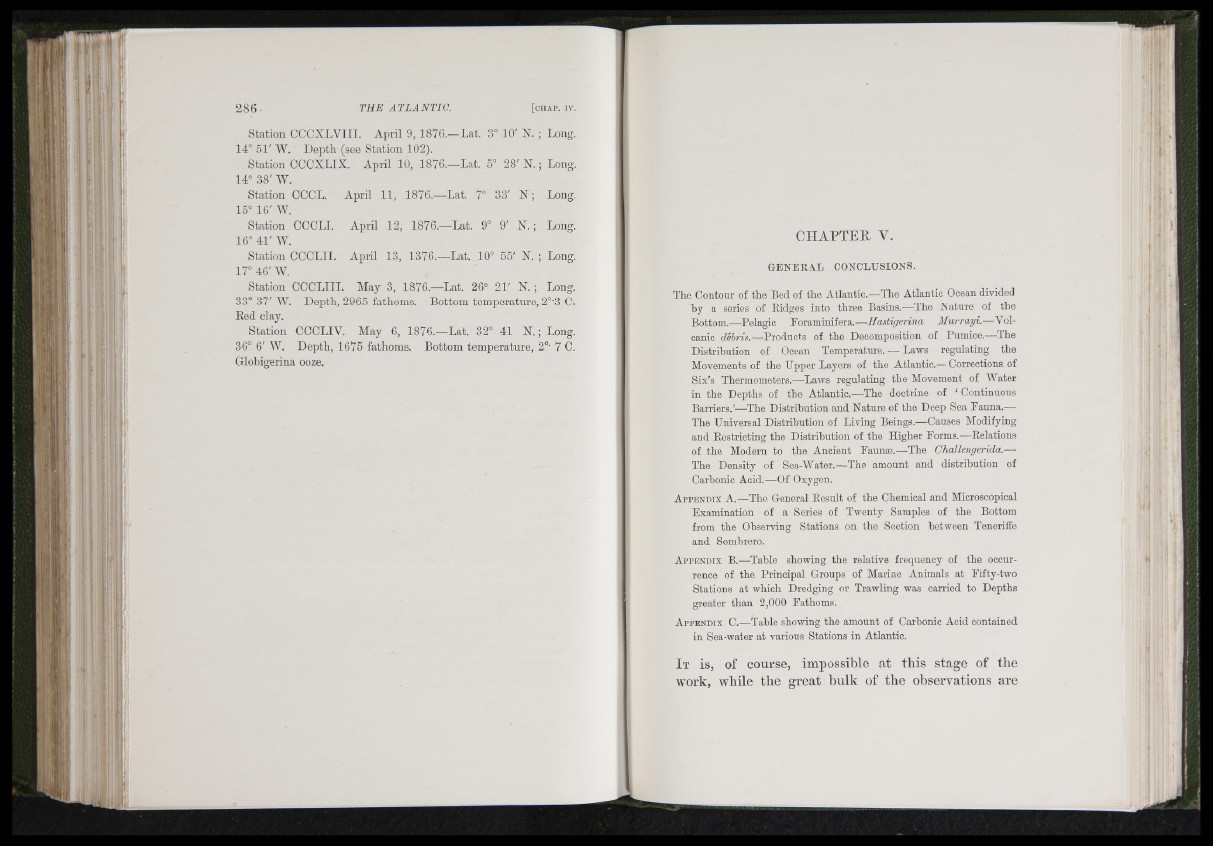
'■lÈ n
i » r : | ; 5
t l's S i G
i 6»
AIT-, I -. .lmit r;
i‘ï'
Station CCCXLVHT. April 9, 187G.-Lat. 3° 10' N. ; Long.
14° 51' W. Depth (see Station 102).
Station CCCXLIX. April 10, 1876.—Lat. 5° 28' K ; Long.
14° 38' W.
Station CCCL. April 11, 1876.—Lat. 7° 33' X ; Long.
15° 16' W.
Station CCCLI. April 12, 1876.—Lat. 9° 9' X . ; Long.
16° 41' W.
Station CCCLII. April 13, 1376.—Lat. 10° 55' N. ; Long.
17° 46' W.
Station CCCLIII. May 3, 1876.—Lat. 26° 21' X. ; Long.
33° 37' W. Depth, 2965 fathoms. Bottom temperature, 2°’3 C.
Bed clay.
Station CCCLIV. May 6, 1876.—Lat. 32° 41 X ; Long.
36° 6' W. Depth, 1675 fathoms. Bottom temperature, 2°- 7 C.
Globigerina ooze.
CHAPTEfi V.
G ENERAL CONCLUSIONS.
The Contour of the Bed of the Atlantic.—'The Atlantic Ocean divided
by a series of Ridges into three Basins.—The Xature of the
Bottom.—Pelagic Foraminifera.—Hastigerina Murrayi.—Y ol-
canic debris.—Products of the Decomposition of Pumice.—The
Distribution of Ocean Temperature. — Laws regulating the
Movements of the Upper Layers of the Atlantic.— Corrections of
Six’s Thermometers.-—Laws regulating the Movement of Water
in the Depths of the Atlantic.-—The doctrine of ‘ Continuous
Barriers.’—The Distribution and Nature of the Deep Sea Fauna.—
The Universal Distribution of Living Beings.—Causes Modifying
and Restricting the Distrihution of the Higher Forms.—Relations
of the Modern to the Ancient Faunæ.—The Challengerida.—
The Density of Sea-Water.—The amount and distrihution of
Carbonic Acid.—Of Oxygen.
A p p e n d i x A.—The General Result of the Chemical and Microscopical
Examination of a Series of Twenty Samples of the Bottom
from the Observing Stations on the Section between Teneriffe
and Sombrero.
A p p e n d i x B.—Table showing the relative frequency of the occurrence
of the Principal Groups of Marine Animals at Fifty-two
Stations at which Dredging or Trawling was carried to Depths
greater than 2,000 Fathoms.
A p p e n d i x C.—Tahle showing the amount of Carbonic Acid contained
in Sea-water at various Stations in Atlantic.
It is, of course, impossible at tbis stage of tbe
work, while the great bulk of tbe observations are